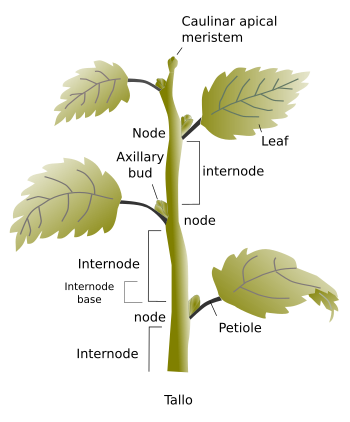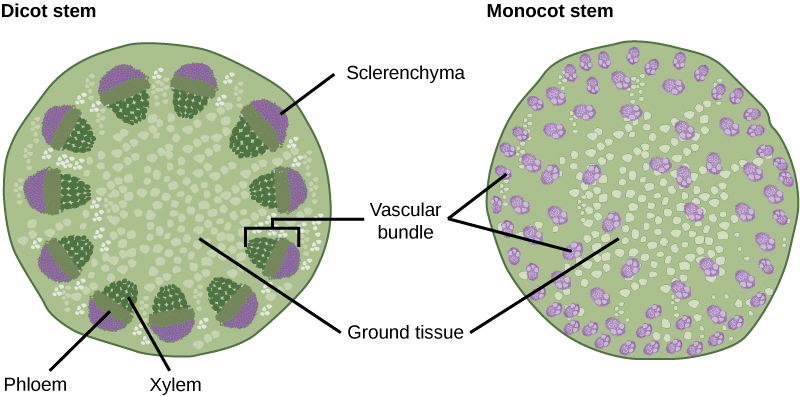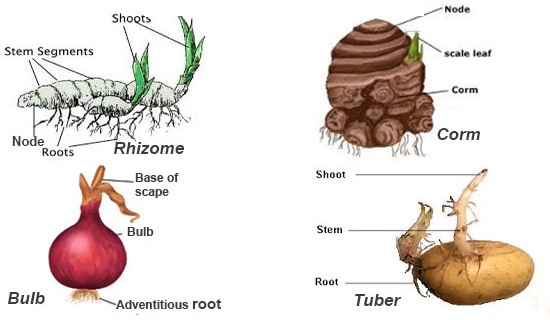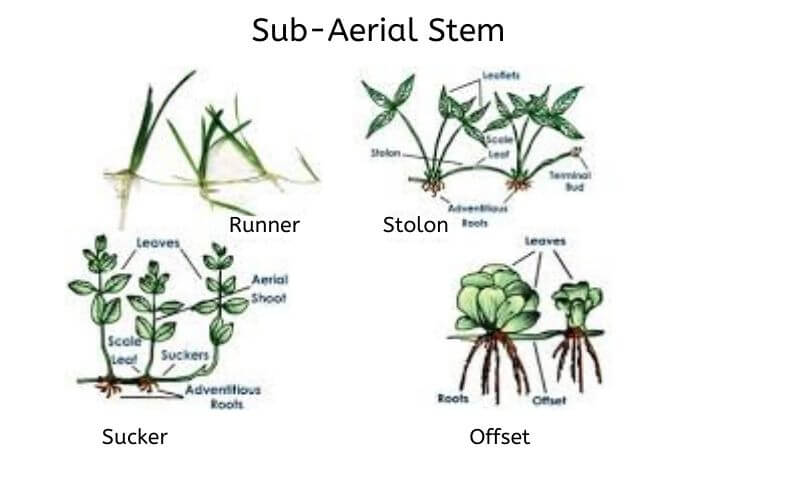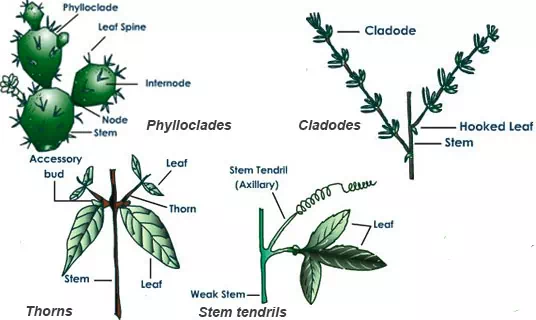Stems Study Guide
Introduction
The stem is generally the axis of the plant that bears buds, shoots with leaves, and roots at its basal end. It is the main structure that transports water, food, and mineral salts to the other parts of plants. Stems also store food, and those that are green generally assist in its production. This guide details out the structures and functions of the stem.
What is a stem?
Stems are part of the shoot systems of a plant. They range in length from a few inches to hundreds of meters, and vary in diameter depending on the type of plant. They usually grow above the ground, although the stem of certain plants like potatoes are found underground.
Stems can be herbaceous or woody. Herbaceous Stems are soft and flexible, such as those found on flowers. Woody Stems are strong and unbendable, such as the trunk of a tree.
Stems are the important structural axis of vascular plants. They connect the roots to the leaves, transport fluids, produce new living tissues, and support leaves, fruits, and flowers. Stems are divided into nodes and internodes.
-
Nodes hold 2 or more leaves and branches together. Adventitious roots also are produced from these nodes.
-
Internodes are the parts of a stem that distance the nodes from each other.
Stem Structure
The important structures in a stem are the pith, protoxylem, xylem, phloem, flax fibers, and cortex.
-
Pith: A soft and spongy tissue that stores starch.
-
Protoxylem: In young stems, protoxylem consists of treachery tissues with spiral thickenings that help in stem growth.
-
Xylem: A vascular tissue that transports water and minerals upwards.
-
Phloem: A vascular tissue that transports food made in the leaves to other plant parts.
-
Flax fibers: The inner bark of stems, composed of bast fibers.
-
Cortex: The outer layer, or epidermis of the stem.
Characteristics and Features of a Stem
-
The stem develops from the plumule and epicotyl of the plant embryo.
-
They are the aerial part of the plant that bears leaves, fruits, flowers, etc.
-
Stems have nodes from which leaves develop.
-
They have terminal and axillary buds which are used for vegetative propagation.
-
The growing stem apex bears a terminal bud for growth.
-
Young stems are green and photosynthetic.
-
If hair is present on a stem, it is generally multicellular.
-
Stems are positively phototropic, meaning they grow towards light, and are negatively geotropic, meaning they grow upwards against gravity.
Stem Functions
-
Provide structures and foundations for plants that will later develop into trees.
-
Some stems help to replicate through vegetative propagation.
-
Grow and support fruits and flowers.
-
Perform a wide range of functions for various biochemical processes such as photosynthesis.
-
Help the plant and its roots stand straight and perpendicular to the grounds.
-
Transport water and mineral salts from the root to the other parts of the plants.
-
Prepare food from leaves.
-
Some stems also undergo modifications to store food and water, for example, succulents.
Types of Stems
Based on their location within the ground, stems are divided into 3 types: underground, subaerial, and aerial.
Underground Stems
Underground stems remain at the ground level and produce aerial shoots that rise above the soil. Their roots are superficially present, and their stems are meant to store food. They are also capable of vegetative propagation. The types of underground stems are tubers, rhizomes, bulbs, corms, and stolons.
-
Tuber: A horizontal stem that is enlarged as a result of storage of food (for example, potatoes).
-
Rhizome: A thick stem with distinct nodes and internodes and scaly leaves at the point of nodes (example: ginger).
-
Bulb: Short stems that possess a fleshy base and leafy scales. The stem here is generally reduced to form disc-like structures (example: onions).
-
Corm: Short and swollen underground stems that grow vertically. They store food and enable plants to survive in adverse circumstances (example: colocasia).
-
Stolons: Slender stems that grow horizontally to the ground that give rise to roots and branches at their nodes (example: spider plant).
Subaerial Stems
Subaerial stems run parallel to the ground and discard their roots at certain nodes at certain intervals. They are divided into four categories: runners, offsets, stolons, and suckers.
Runners: They have a creeping stem with elongated internodes. They develop from the axis of low leaves of the aerial stems (example: strawberry).
Offset: They are thicker and shorter than runners. They are also often seen in aquatic plants (example: water lettuce).
Stolon: They are similar to runners, but they arise from low parts of the main axis (example: silverweed).
Sucker: This type is similar to stolons, but they grow upwards and give rise to new plants (example: lilac).
Aerial Stems
Aerial stems are are found above the ground and are divided into three types: thorns, tendrils, and bulbils.
Thorns: Modifications of the stem that are hard, sharp, and woody to protect plants (example: roses).
Tendrils: Slender stems that enable plants to seek support when climbing on other surfaces (example: watermelon).
Bulbil: They are modifications of axillary buds; they are fleshy and rounded as a result of storing food (example: lily).
Conclusion
-
Stems are the important structural axis of vascular plants. They support leaves, fruits, flowers and produce new living tissues.
-
Stems give accurate structures and foundations for plants.
-
Stems are divided into 3 types: Underground stems, Subaerial stems, and Aerial stems.
-
Stems help transport water and minerals from the root to the other parts of the plants and help prepare food from leaves.
FAQs
1. What are the three types of aerial stems?
- Thorns, tendrils, and bulbils.
2. Is sweet potato a stem or root?
- Sweet potato is a root tuber.
3. Is a potato a root or stem?
- A potato is a modification of the stem into a tuber that stores food.
4. What are the types of stems based on their location in the ground?
- Underground, subaerial, and aerial.
5. Give an example of a bulbil stem.
- Garlic, tulip, daffodil, onion, etc.
6. What are the four types of subaerial stems?
- Runner, offset, stolon, and sucker.
We hope you enjoyed studying this lesson and learned something cool about Stems! Join our Discord community to get any questions you may have answered and to engage with other students just like you! Don’t forget to download our App to experience our fun, VR classrooms – we promise, it makes studying much more fun! 😎
Sources
-
Stems. https://flexbooks.ck12.org/cbook/ck-12-biology-flexbook-2.0/section/9.15/primary/lesson/stems-bio/ Accessed 9 Dec, 2021.
-
Plant Tissues and Organs Study Guide. https://flexbooks.ck12.org/studyguides/biology/plant-tissue-and-organs-study-guide.html?encodedID=SCI.BIO.631&courseContextID=5292077 Accessed 9 Dec, 2021.

